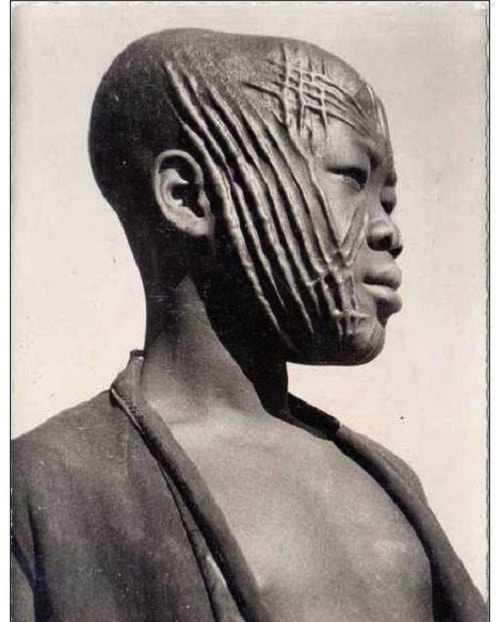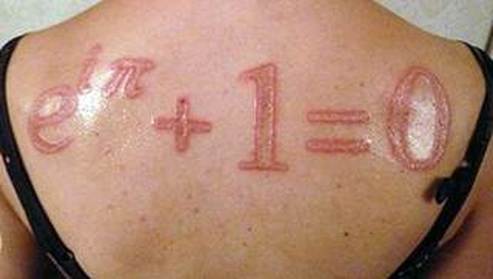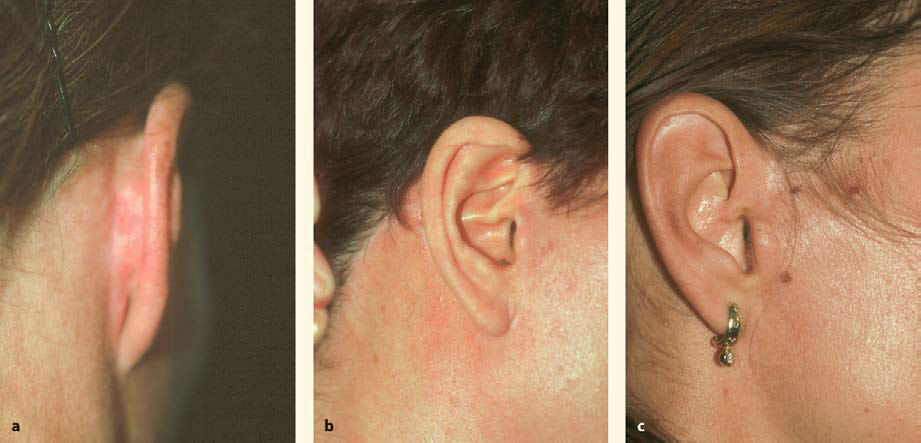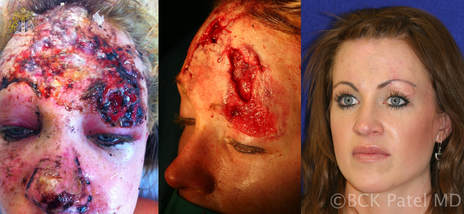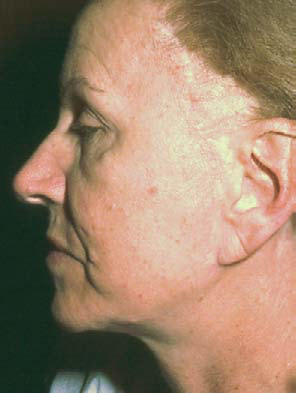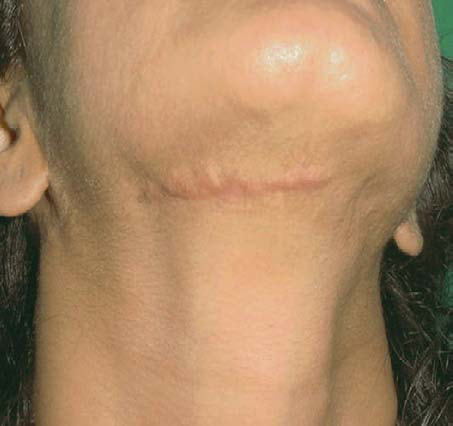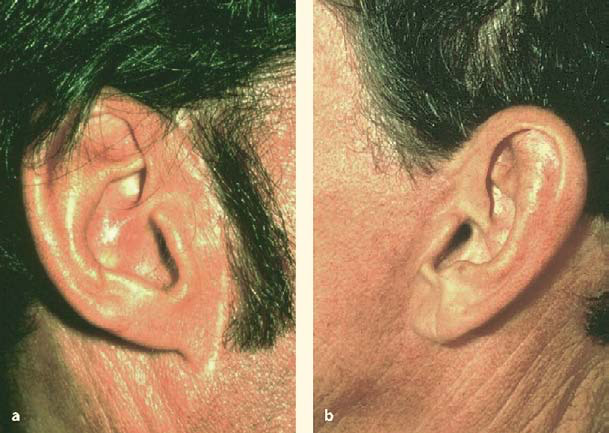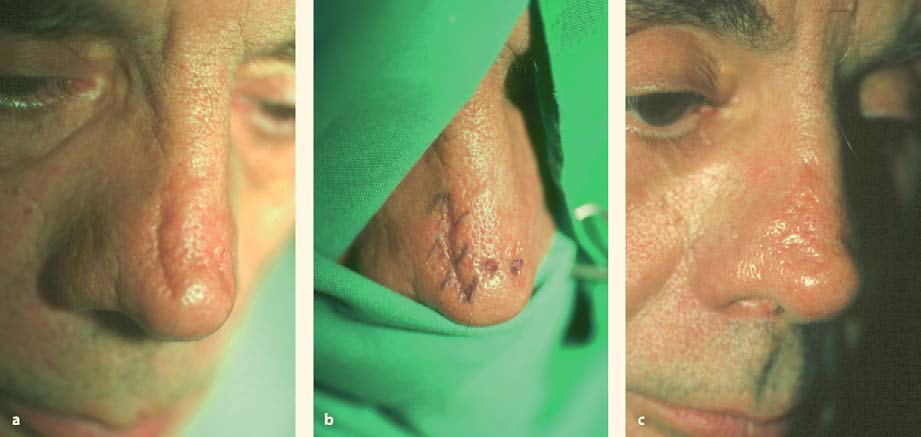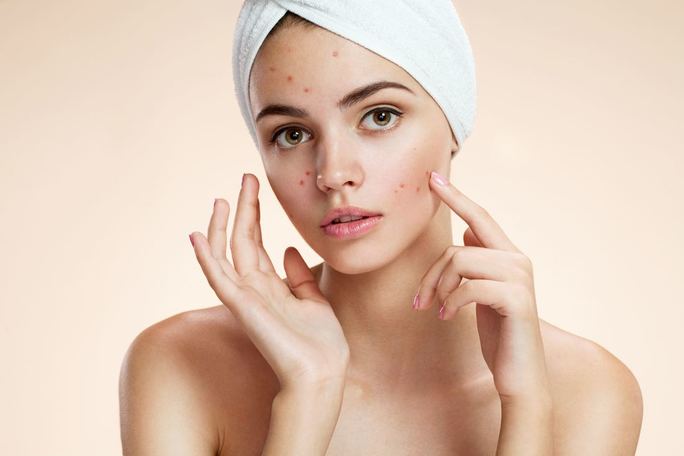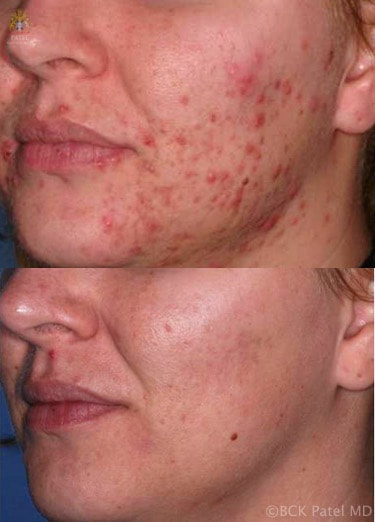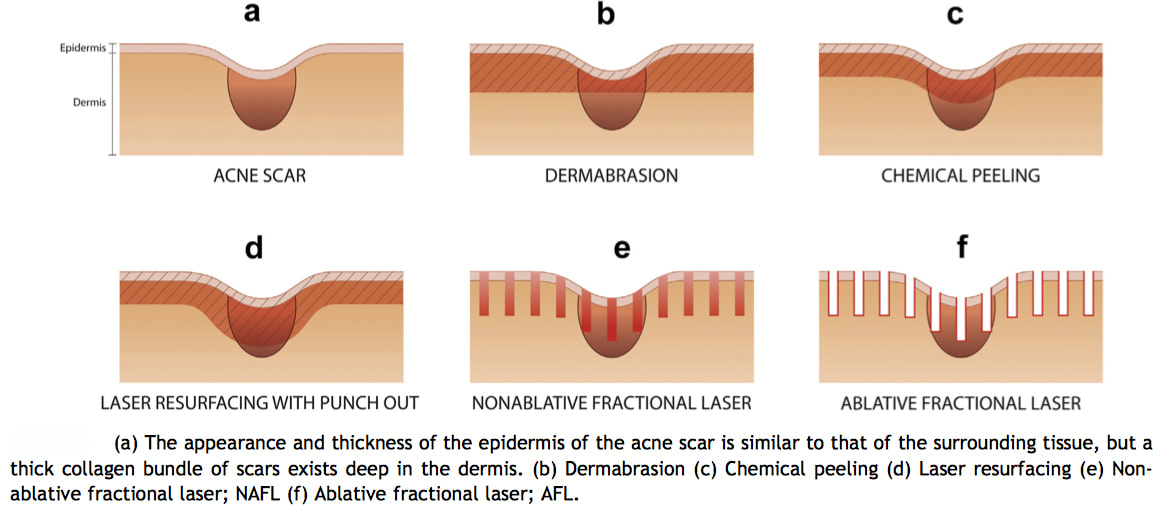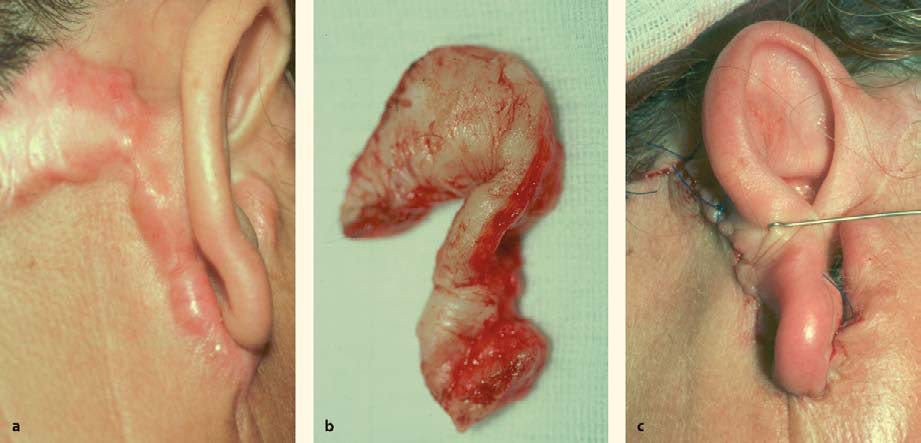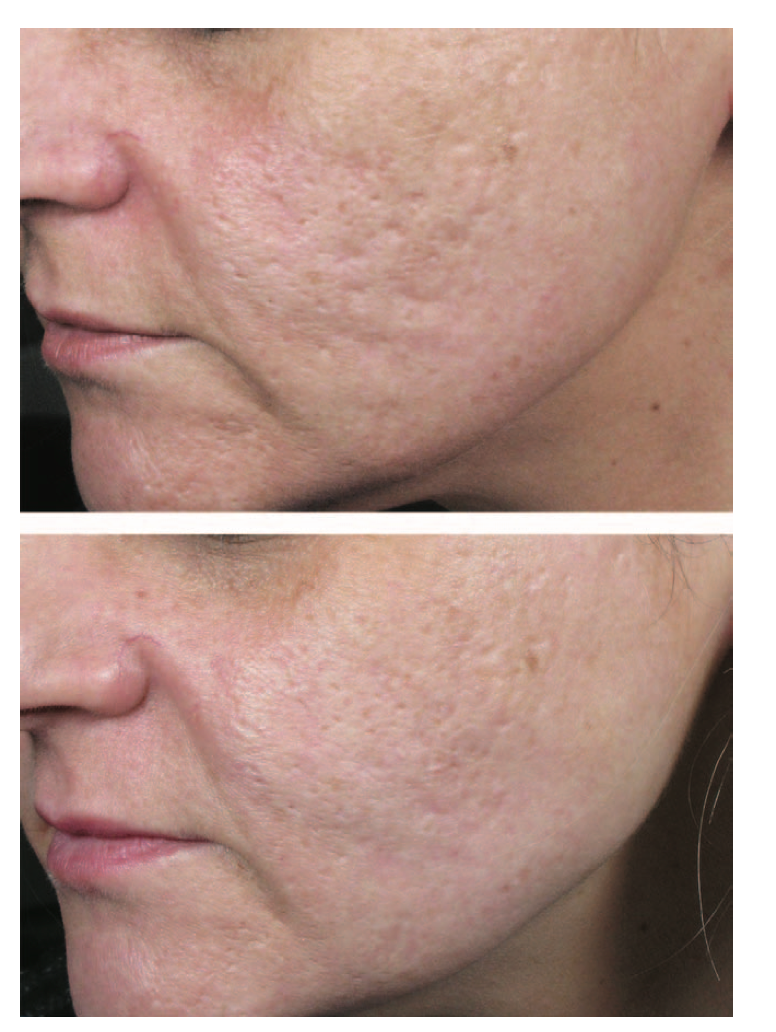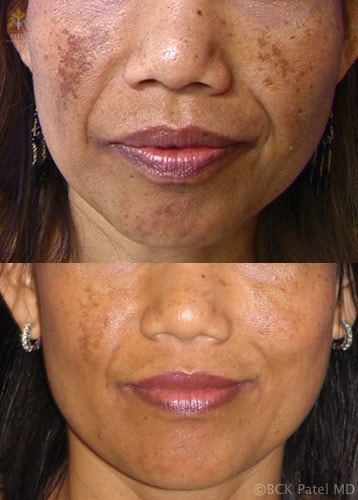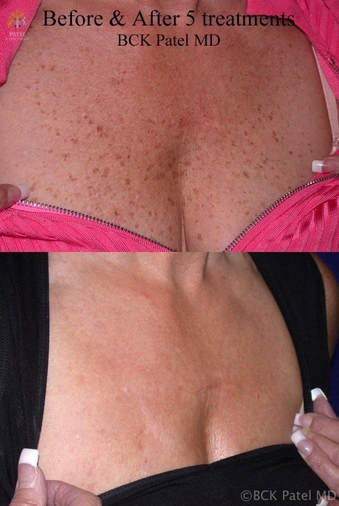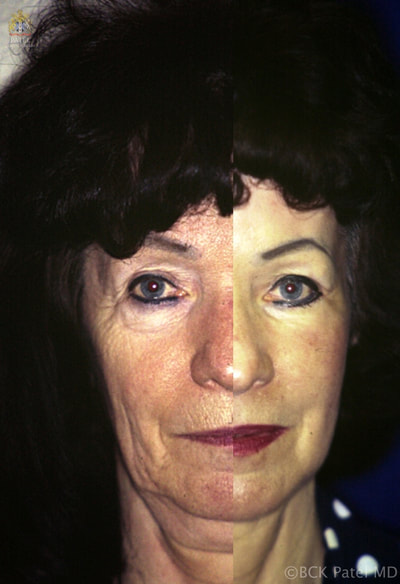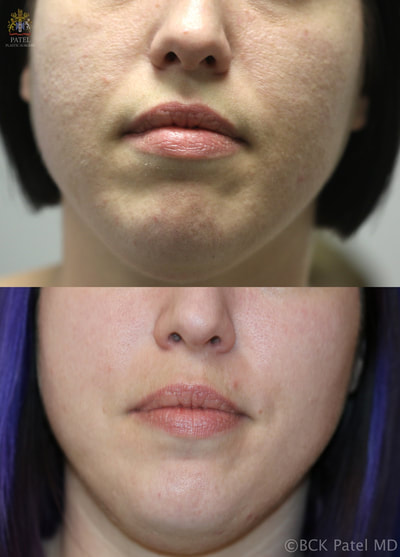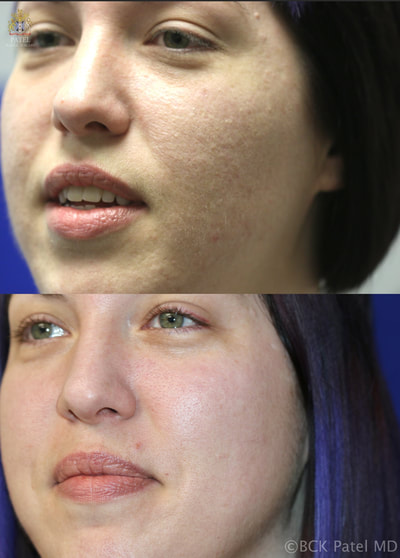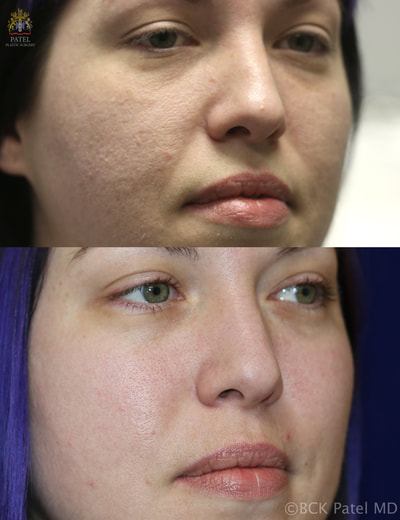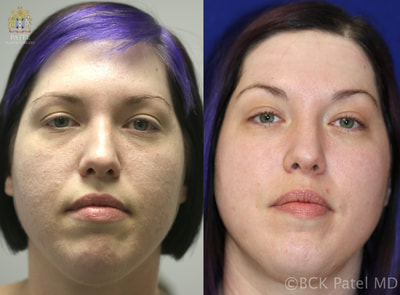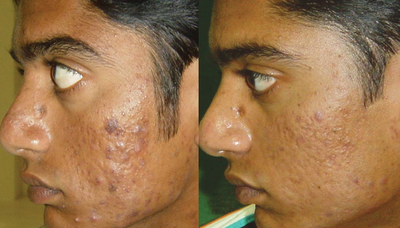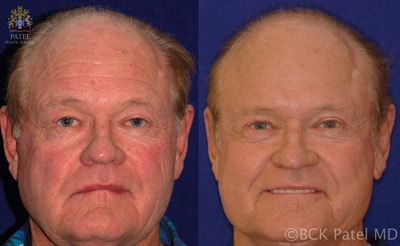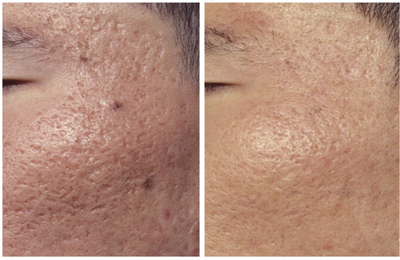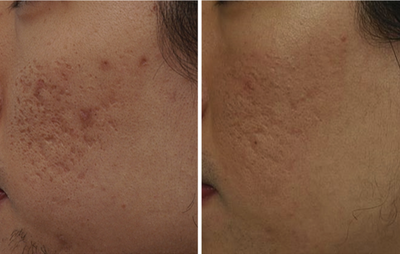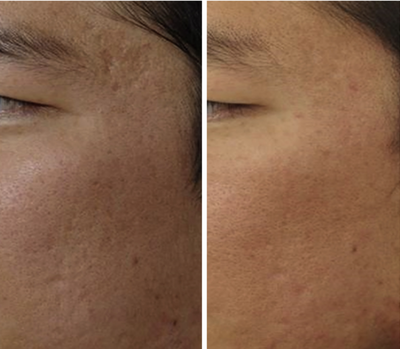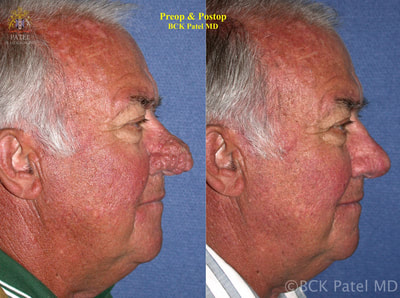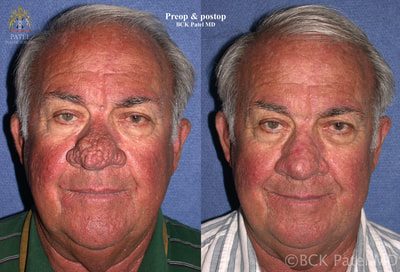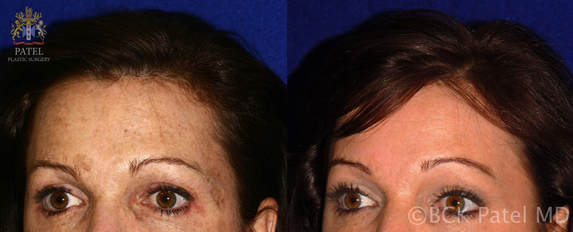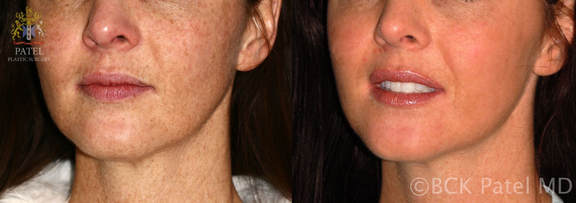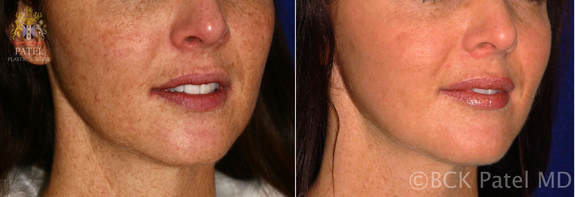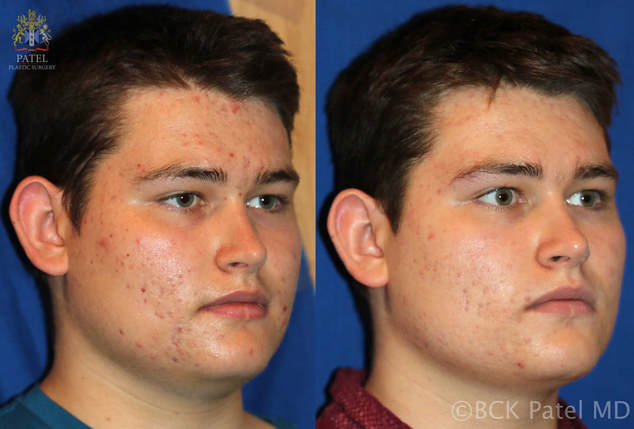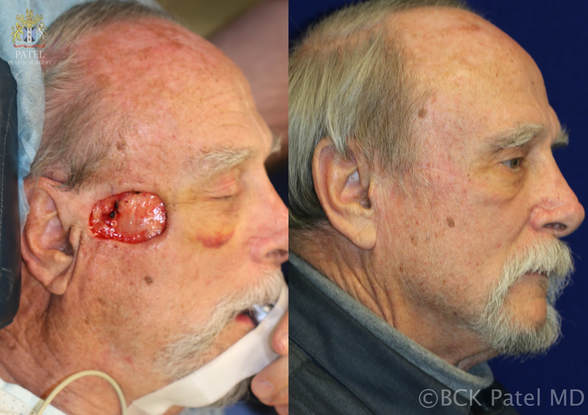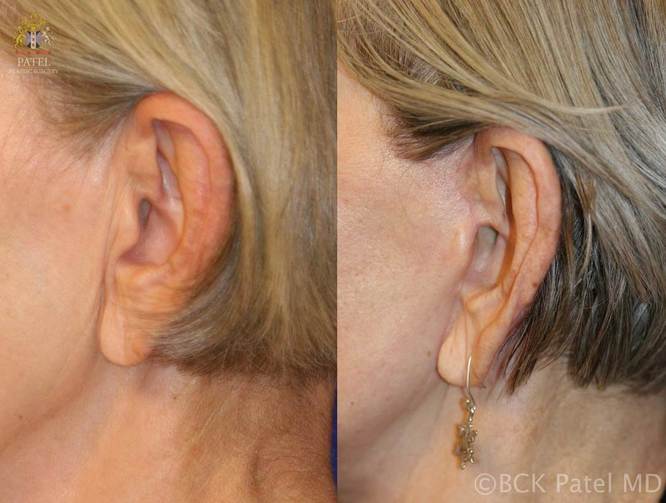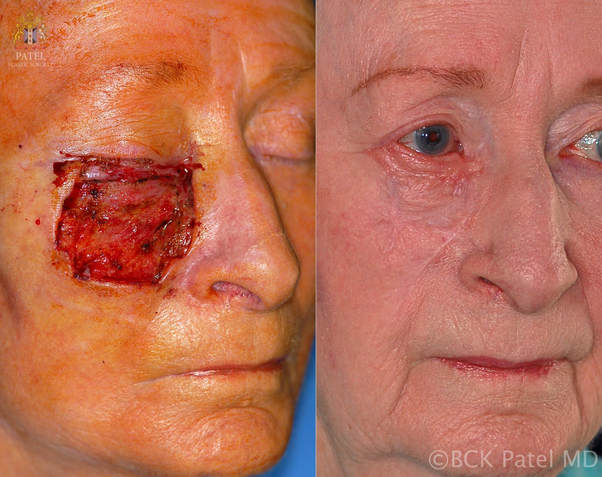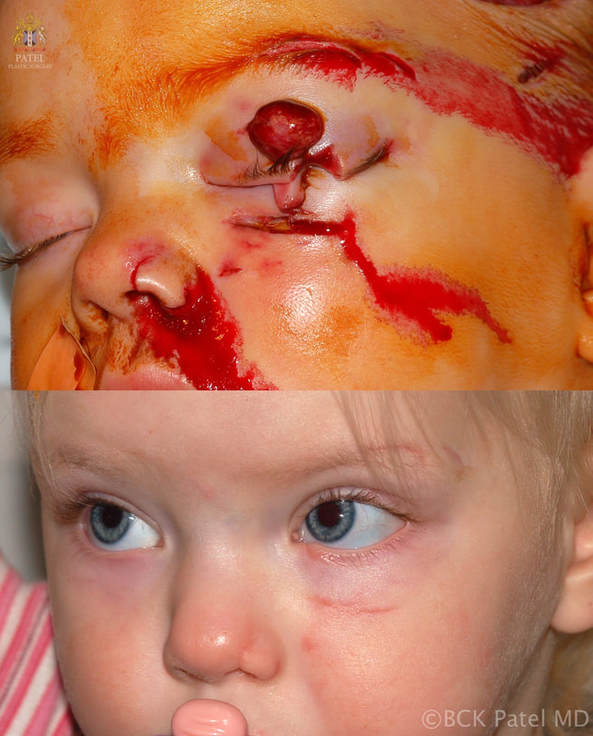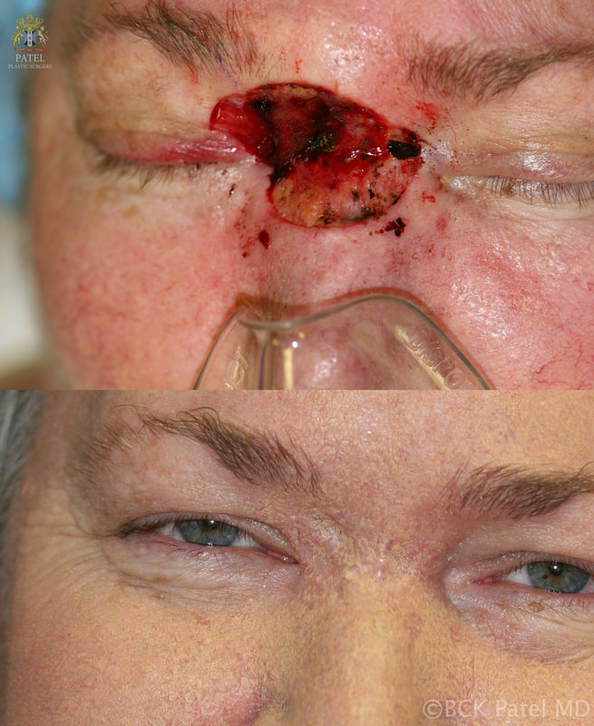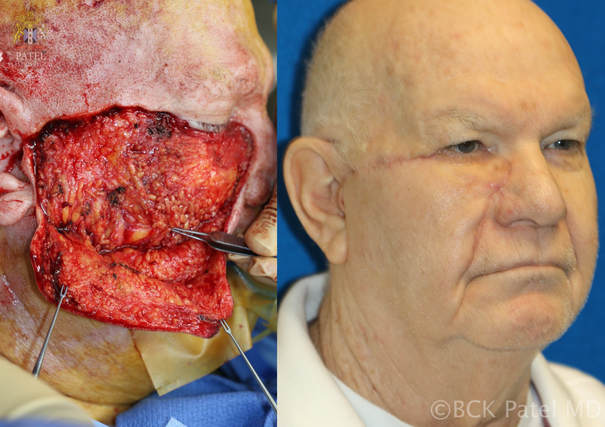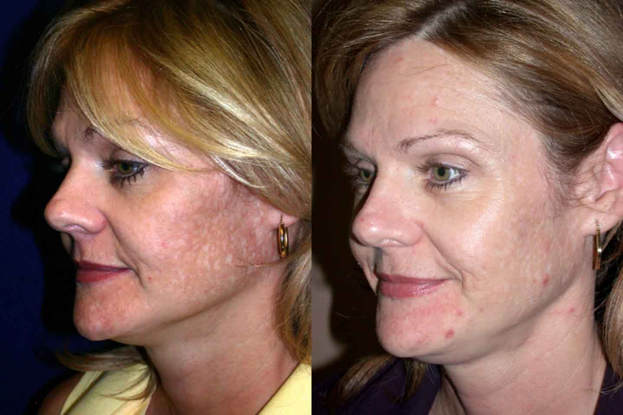facial scars
The word “scar” commands attention: it is the effect of anything that disturbs the slumber of our skin! Indeed, trauma, infections, surgery, tattoos, piercing, may all cause one type of scar or another.
The word “scar” is derived from the old Greek, eskhara which means “fireplace” but the effect of the burn is what gives us the Latin word eschara or the Old French escharre.
Of all the scars that may afflict us, the ones on the face are visible to all and bother us, understandably, the most. Some people, often young boys and men, regard scars from sporting injuries or fights as the rights of passage leading to manhood! Indeed, in some cultures, scarification is used to denote the progression into adulthood.
The word “scar” is derived from the old Greek, eskhara which means “fireplace” but the effect of the burn is what gives us the Latin word eschara or the Old French escharre.
Of all the scars that may afflict us, the ones on the face are visible to all and bother us, understandably, the most. Some people, often young boys and men, regard scars from sporting injuries or fights as the rights of passage leading to manhood! Indeed, in some cultures, scarification is used to denote the progression into adulthood.
What can we do about these scars? Do lasers hold some promise for getting rid of our scars? What are the techniques for treating them?
What are the types of Scars?
- Acne scars
- Surgical scars and accident-related scars
- Keloids and hypertrophic scars
- Stretch marks
What are the Possible Treatments?
In plastic surgery, a careful history and examination together with an understanding of the cause and age of the scar is vital if one is to plan a successful campaign to improve scars. Depending upon the details, treatment may involve one or more of the following treatments:
- Subscision of acne scars
- Lasers for acne scars
- Dermabrasion for acne scars
- Chemical peels for acne scars
- Hyaluronic fillers, like Restylane and Juvederm
- Punch grafting
- Paper tape, silicone, Mederma gel, Biafine, and other topical treatments
- Lasers for keloids, hypertrophic, and red scars
- Injections into scars (steroids, 5-FU)
- Re-excision of scars
- Lasers for stretch marks
- “Z” plasty, “W” plasty, geometric broken line repair, flaps, grafts
Types of Scars
Acne Scars
What is an acne scar? This is actually a more complicated question than you might think. Many types of acne leave a red or sometimes brownish mark on the skin after the lesion heals. These are temporary and go away in two to six months. They are not true acne scars. Many patients are confused by this and think that the temporary discolorations are in fact scars.
True acne scarring is a permanent depression, elevation, or white area on the skin. Acne scarring follows cystic acne (hard, tender, deep lesions) or sometimes very inflamed pustular acne (plugged pores with pus in them). The texture of a true scar is usually firmer than the surrounding skin.
There are also different types of acne scars. For example, one type of scar, called an “ice pick” scar, leaves a deep scar with a narrow opening at the skin, as if a tiny ice pick had punctured the skin.
Other acne scars affect the surface of the skin and can have either rolling soft shoulders or sharply demarcated, almost perpendicular, box-like walls. Still other types of acne scarring may look like very enlarged pores in areas where the acne was active.
The treatment recommended would vary according to the type of scar and the amount of scarring that you have. The most common acne scar treatments are simple excision, subscision, punch grafting, laser treatments, dermabrasion, and hyaluronic fillers like Restylane and Juvederm.
Surgical Scars
“After many operations, I have healed well. However, following shoulder surgery six months ago, I have a large, ugly scar. Why is this different from the others?”
Scars on different parts of the body heal differently: scars on the face and eyelids generally heal well, even in patients predisposed to hypertrophic or keloid scarring. However, scars on joints, on the chest and back generally heal with some degree of scarring. Indeed, even in patients not prone to excessive scarring, scars on the sternum (middle of the chest), often heal with hypertrophic or keloid scars.
Overall, the more tension there is on the scar while it is healing, the more likely it is to show scarring. For example, scars around the eyelids heal very nicely because there is usually extra skin and thus very little tension on the scar. Also, think skin (the eyelids have the thinnest skin in the body) generally heal very well. Similarly, caesarian section scars right above the pubic bone also often heal well, because after delivery there is extra skin and almost no tension on the scar.
But scars over a joint, like your shoulder surgery, get a lot of tension. The joint, the skin, and the scar move frequently, and often the skin is pulled somewhat tightly over the joint. And the more heavily muscled you are, the more stretch the scar gets. While a scar on your abdomen may heal into a nice neat white line, a scar over a shoulder or a knee can spread and look quite wide.
When we are older, our skin is looser and less elastic. So there is less tension on wounds, which results in smaller, less obtrusive scars. Conversely, in younger people there is a lot of skin elasticity, which places more tension on the wound and tends to make the scars spread more.
Almost all surgeons do what they can to minimize the scar spreading by putting in absorbable stitches down in deeper layers of the skin where you can’t see them. These absorbable sutures relieve tension on the wound by reinforcing the layers of skin under the surface of the wound. These deeper stitches support the skin while it is healing after the superficial stitches are taken out and last anywhere from four to twelve weeks. This helps, but is not a complete cure-all.
Your surgeon may ask you to limit your activity and wear surgical tape or steri-strips over the scar for many months to help keep the scar flat, soft, and narrow. Advanced surgical training teaches our residents and fellows how to suture properly, choose the correct sutures, how to handle tissues, how to relieve tension in the important healing phase, learn when to remove sutures, and teach the patient how to care for the wound! A true plastic surgeon is judged by his scars!
Scars on different parts of the body heal differently: scars on the face and eyelids generally heal well, even in patients predisposed to hypertrophic or keloid scarring. However, scars on joints, on the chest and back generally heal with some degree of scarring. Indeed, even in patients not prone to excessive scarring, scars on the sternum (middle of the chest), often heal with hypertrophic or keloid scars.
Overall, the more tension there is on the scar while it is healing, the more likely it is to show scarring. For example, scars around the eyelids heal very nicely because there is usually extra skin and thus very little tension on the scar. Also, think skin (the eyelids have the thinnest skin in the body) generally heal very well. Similarly, caesarian section scars right above the pubic bone also often heal well, because after delivery there is extra skin and almost no tension on the scar.
But scars over a joint, like your shoulder surgery, get a lot of tension. The joint, the skin, and the scar move frequently, and often the skin is pulled somewhat tightly over the joint. And the more heavily muscled you are, the more stretch the scar gets. While a scar on your abdomen may heal into a nice neat white line, a scar over a shoulder or a knee can spread and look quite wide.
When we are older, our skin is looser and less elastic. So there is less tension on wounds, which results in smaller, less obtrusive scars. Conversely, in younger people there is a lot of skin elasticity, which places more tension on the wound and tends to make the scars spread more.
Almost all surgeons do what they can to minimize the scar spreading by putting in absorbable stitches down in deeper layers of the skin where you can’t see them. These absorbable sutures relieve tension on the wound by reinforcing the layers of skin under the surface of the wound. These deeper stitches support the skin while it is healing after the superficial stitches are taken out and last anywhere from four to twelve weeks. This helps, but is not a complete cure-all.
Your surgeon may ask you to limit your activity and wear surgical tape or steri-strips over the scar for many months to help keep the scar flat, soft, and narrow. Advanced surgical training teaches our residents and fellows how to suture properly, choose the correct sutures, how to handle tissues, how to relieve tension in the important healing phase, learn when to remove sutures, and teach the patient how to care for the wound! A true plastic surgeon is judged by his scars!
Accident-related Scars
“I was recently in a terrible car accident and was left with several unsightly scars. My doctor said I should wait at least a six months to a year before I consider having these treated. Why is that?”
Assuming that these lacerations were cleaned and stitched up appropriately by a skilled emergency room physician or a plastic surgeon, then waiting six to twelve months to do anything about a scar may make sense. Scars attain only about 60 percent of their final wound strength at about six to eight weeks after surgery. Then, the scar will slowly mature on its own for even up to a year after the accident or surgery. If you’re not sure what to do, have your dermatologist look at it.
Since the stitches usually come out of wounds at one to two weeks, good surgeons will often reinforce a scar for weeks to months afterwards by using steri-strips (special type of postsurgical tape) or surgical paper tape that you can buy at the drugstore. Reinforcing the wound by keeping the scar tightly closed and as flat as possible maximizes your chances of a smaller scar. We use proper deep tissue closure with sutures that dissolve slowly, thereby providing us with support to the more superficial tissues, thereby giving us better scars. Indeed, with the use of sutures that do not leave track marks, we sometimes elect to leave sutures in for longer than the traditional five days when it comes to facial wounds and repairs.
Scars continue to remodel silently under the surface of the skin for up to a year after the injury. This is why many doctors recommend waiting. The appearance of the scar will gradually improve over time without your having to do anything about it. Your own bodies’ healing mechanisms are really quite amazing. If after six months to a year the scar is still quite red, raised, or irregular in some other way, then it may be time to consider some of the options discussed in the next section.
The exception to this is development of a possible keloid. If after six to eight weeks or longer, the scar becomes itchy, painful or more raised, we would address the scar promptly.
Assuming that these lacerations were cleaned and stitched up appropriately by a skilled emergency room physician or a plastic surgeon, then waiting six to twelve months to do anything about a scar may make sense. Scars attain only about 60 percent of their final wound strength at about six to eight weeks after surgery. Then, the scar will slowly mature on its own for even up to a year after the accident or surgery. If you’re not sure what to do, have your dermatologist look at it.
Since the stitches usually come out of wounds at one to two weeks, good surgeons will often reinforce a scar for weeks to months afterwards by using steri-strips (special type of postsurgical tape) or surgical paper tape that you can buy at the drugstore. Reinforcing the wound by keeping the scar tightly closed and as flat as possible maximizes your chances of a smaller scar. We use proper deep tissue closure with sutures that dissolve slowly, thereby providing us with support to the more superficial tissues, thereby giving us better scars. Indeed, with the use of sutures that do not leave track marks, we sometimes elect to leave sutures in for longer than the traditional five days when it comes to facial wounds and repairs.
Scars continue to remodel silently under the surface of the skin for up to a year after the injury. This is why many doctors recommend waiting. The appearance of the scar will gradually improve over time without your having to do anything about it. Your own bodies’ healing mechanisms are really quite amazing. If after six months to a year the scar is still quite red, raised, or irregular in some other way, then it may be time to consider some of the options discussed in the next section.
The exception to this is development of a possible keloid. If after six to eight weeks or longer, the scar becomes itchy, painful or more raised, we would address the scar promptly.
Keloid and Hypertrophic Scars
“I have recently had a mole taken off in the middle of my chest. It now looks worse than it did before and is hard, raised, sometimes painful and itchy.”
This sounds like a keloid or hypertrophic scar. Let’s just call these keloids since the treatment is usually the same for both. Keloids are scars that become raised, firm, painful and/or itchy instead of staying flat and soft through the healing process.
Keloid formation often begins four to eight weeks after the procedure but can occur later as well. Keloids can occur after any type of skin injury or in response to skin diseases where there is a lot of inflammation, like acne.
Keloids can occur just about anywhere on the body but are most common on the chest, over the shoulders and upper back, and at sites of piercing, particularly the ears. Keloids are also age related. The risk for them jumps at puberty (around 12 or 13) and gradually increases through the late teens and 20s. The risk starts to go down again in the 30s. A few unlucky individuals are keloid-prone their entire lives.
This sounds like a keloid or hypertrophic scar. Let’s just call these keloids since the treatment is usually the same for both. Keloids are scars that become raised, firm, painful and/or itchy instead of staying flat and soft through the healing process.
Keloid formation often begins four to eight weeks after the procedure but can occur later as well. Keloids can occur after any type of skin injury or in response to skin diseases where there is a lot of inflammation, like acne.
Keloids can occur just about anywhere on the body but are most common on the chest, over the shoulders and upper back, and at sites of piercing, particularly the ears. Keloids are also age related. The risk for them jumps at puberty (around 12 or 13) and gradually increases through the late teens and 20s. The risk starts to go down again in the 30s. A few unlucky individuals are keloid-prone their entire lives.
It is important to tell your doctors and particularly surgeons if you are keloid-prone, because keloids caught early are much easier to treat than ones that have been present for a long time. With special surgical techniques and injections they can sometimes even be prevented after surgeries. Once they have developed fully and have matured, they can be quite difficult to treat and may require multiple visits to the doctor to get and keep them under control.
Common treatments include injections of potent anti-inflammatory drugs into the scar or using tape, silicone gel, or a topical like Biafine on the scar. Lasers can improve the color, but are not to the point yet where they can significantly improve the keloid itself.
Stretch marks
Stretch marks are a special kind of scar that occurs from inside the skin rather than from a tear or incision in skin. When skin is asked to stretch too far too quickly, the collagen and elastic fibers that hold the deeper layers of skin together rupture, creating a deep tear but no surface tear.
The most common situation for this is over the abdomen in pregnancy, especially with twins or triplets. Stretch marks are also common in teenagers during growth spurts, particularly over joints like the shoulders in boys or over areas like the hips in girls. Rapid weight gain in adulthood can cause them.
There is no cure yet for stretch marks, and there is no hard evidence that massaging in Vitamin E oil or other creams will help. There have been some reports that microdermabrasion and or Retin A may help, but these have not been confirmed in studies involving large numbers of people.
We have been able to get moderately good results in appearance and texture for stretch marks with the Fraxel laser (nonablative fractional laser) together with radiofrequency delivered under the skin. If the stretch marks are red, lasers can definitely help normalize the color.
Fractional lasers when used with the pale stretch marks also give an improvement in the appearance of the stretch marks but certainly not a cure!
Some stretch marks will fade with time on their own without any treatment.
The most common situation for this is over the abdomen in pregnancy, especially with twins or triplets. Stretch marks are also common in teenagers during growth spurts, particularly over joints like the shoulders in boys or over areas like the hips in girls. Rapid weight gain in adulthood can cause them.
There is no cure yet for stretch marks, and there is no hard evidence that massaging in Vitamin E oil or other creams will help. There have been some reports that microdermabrasion and or Retin A may help, but these have not been confirmed in studies involving large numbers of people.
We have been able to get moderately good results in appearance and texture for stretch marks with the Fraxel laser (nonablative fractional laser) together with radiofrequency delivered under the skin. If the stretch marks are red, lasers can definitely help normalize the color.
Fractional lasers when used with the pale stretch marks also give an improvement in the appearance of the stretch marks but certainly not a cure!
Some stretch marks will fade with time on their own without any treatment.
Treatment of Scars
|
“Is acne scarring preventable now?”
Yes, for the most part we can. If scarring acne (usually cystic or pustular acne) is caught early in its course and treated with Accutane or an aggressive course of oral antibiotics, oral contraceptives (for females), and topical agents, it is possible now to stop scarring acne in its tracks before it becomes permanent and widespread. If you have any signs that your acne might be starting to scar, see your dermatologist as quickly as possible to get started on treatment. If conservative acne treatment isn’t working after two or three months, consider Accutane. Or, if your acne is severe enough, it may be appropriate to start with Accutane. Modern dermatology has a cascade of treatments so that one starts with the simpler topical treatments, followed by more aggressive treatments which can involve prescription medication like spironolactone, tetracycline drugs, contraceptive pills in ladies and Accutane. |
"Well, the last time I had a picture taken I could hardly see my eyes because of the weight of heavy eyelid. Then I paid attention to how I was actually using my eyes and I really noticed when I was looking at anything especially the computer I was straining my forehead to see better. Since I have had it done I no longer have to lift the forehead and tilt my head to see. It is amazing! I love..." D. Rock 63 Yrs Old with Fat Droopy Eyes - Salt Lake City, UT
Excision of Acne Scars
Some acne scars can be treated with excision. This works best on acne scars that have a narrow opening but are deep (the “ice pick” scars). A tiny tool that looks like a round cookie cutter and comes in a number of different sizes can be used to excise the entire acne scar. One or two tiny stitches are then put in to hold the new edges together to make the skin surface smooth and flat.
After the stitches have come out and the area heals, sometimes it looks fine on its own. If it still needs some work, a chemical or laser peel may improve the appearance of the area even more. This can be done in conjunction with punch grafting also, which is discussed below.
After the stitches have come out and the area heals, sometimes it looks fine on its own. If it still needs some work, a chemical or laser peel may improve the appearance of the area even more. This can be done in conjunction with punch grafting also, which is discussed below.
Subcision of Scars
“My acne scars are more shallow, somewhat broad depressions in my face rather than the deeper holes. My doctor has mentioned scar subscision. Please explain acne scar subscision.”
Subcision is the dissection under shallow acne cars which releases the fibrous bands that exist under such scars. These types of scars are more shallow than the ice pick types of scars.
To understand this acne scar treatment, you need to understand how you got your scars. The depressions in your skin developed because the acne lesion disrupted the normal formation of collagen under your skin as it healed. The collagen did not form in a normal, smooth, wavy layer running parallel to the surface of your skin. Instead, the collagen bunched up into thick bundles that pulled down the surface of your skin permanently.
During scar subscision, your doctor numbs the area first, and then pushes a small needle through the skin down to the area where the collagen is all bunched up. One then works the needle around to break up that abnormal collagen layer. Often, a small pocket fills with blood under the scar. As the area heals, the new collagen formation pushes the base of the acne scar up a little. In some cases we inject a filler after subcision of scars.
Subscision is often followed 6 weeks later with a gentle laser to stimulate collagen growth.
It usually takes anywhere from one to four treatments depending on how deep the scar is to lift the scar area up close to level with the skin surface. You will usually see small improvements in your acne scars after each treatment. The only downside to this needle technique of subscision is the bruise that is left right after the procedure. The bruise generally lasts approximately one to two weeks and is annoying; but it can usually be covered with makeup while the area is healing. The time between treatments is generally four to twelve weeks.
After you have had as much improvement in your acne scars as you can get with the subscision, you may want to consider laser treatments (more on this later), dermabrasion, or a medium depth TCA peel to even out the skin’s surface even more.
Subcision is the dissection under shallow acne cars which releases the fibrous bands that exist under such scars. These types of scars are more shallow than the ice pick types of scars.
To understand this acne scar treatment, you need to understand how you got your scars. The depressions in your skin developed because the acne lesion disrupted the normal formation of collagen under your skin as it healed. The collagen did not form in a normal, smooth, wavy layer running parallel to the surface of your skin. Instead, the collagen bunched up into thick bundles that pulled down the surface of your skin permanently.
During scar subscision, your doctor numbs the area first, and then pushes a small needle through the skin down to the area where the collagen is all bunched up. One then works the needle around to break up that abnormal collagen layer. Often, a small pocket fills with blood under the scar. As the area heals, the new collagen formation pushes the base of the acne scar up a little. In some cases we inject a filler after subcision of scars.
Subscision is often followed 6 weeks later with a gentle laser to stimulate collagen growth.
It usually takes anywhere from one to four treatments depending on how deep the scar is to lift the scar area up close to level with the skin surface. You will usually see small improvements in your acne scars after each treatment. The only downside to this needle technique of subscision is the bruise that is left right after the procedure. The bruise generally lasts approximately one to two weeks and is annoying; but it can usually be covered with makeup while the area is healing. The time between treatments is generally four to twelve weeks.
After you have had as much improvement in your acne scars as you can get with the subscision, you may want to consider laser treatments (more on this later), dermabrasion, or a medium depth TCA peel to even out the skin’s surface even more.
Laser Treatments of Scars
“What are the different types of lasers used for acne scar treatment and how do they work?”
The most exciting development in laser acne scar treatment is the new fractional laser technology. The fractional lasers break the laser beam up into tiny little pixels or shafts of light. So the area treated is like a lawn being aerated, with little plugs of laser treatment. This causes less damage and less downtime and allows for a more powerful treatment.
The fractional lasers give good results on acne scars. This is true even with the deeper ice pick scars. As with all treatments, some people and some scars respond better than others. Nobody can guarantee that scars will be completely gone with any particular treatment. With a series of Fraxel laser treatments, most people can expect a 50-70% improvement in their acne scars.
The most exciting development in laser acne scar treatment is the new fractional laser technology. The fractional lasers break the laser beam up into tiny little pixels or shafts of light. So the area treated is like a lawn being aerated, with little plugs of laser treatment. This causes less damage and less downtime and allows for a more powerful treatment.
The fractional lasers give good results on acne scars. This is true even with the deeper ice pick scars. As with all treatments, some people and some scars respond better than others. Nobody can guarantee that scars will be completely gone with any particular treatment. With a series of Fraxel laser treatments, most people can expect a 50-70% improvement in their acne scars.
Ablative fractional CO2 lasers are the best modalities of treatment, although in some patients, the erbium laser will also give nice results if the patient does not have sufficient down time.
Other newer treatments which are giving us nice results are radiofrequency devices which allow us to deliver energy below the surface of the skin. Secondary collagen tightening and formation of new collagen helps improve the texture and appearance of the skin.
Other newer treatments which are giving us nice results are radiofrequency devices which allow us to deliver energy below the surface of the skin. Secondary collagen tightening and formation of new collagen helps improve the texture and appearance of the skin.
Laser treatment of acne scars is both a science and an art and takes considerable experience to do it really well. Good laser providers can tell pretty much exactly what depth they are working in by the appearance of the skin and with their experience on different parts of the face. For example, the skin over the nose is much thicker than the skin right around the jaw line. The laser provider adjusts the depth according to the part of the face being worked on and to the depth of the acne scarring itself. To see what can be done if we use the laser with attention to detail, see what is possible with patients who have severe acne rosacea and rhinophyma, which is just like acne scarring, only many times worse!
Hyaluronic Acid Fillers for Acne Scars: Restylane and Juvederm
“My dermatologist recommended Restylane for my acne scars. Do you have an opinion on this?”
Restylane and Juvederm injections work quite nicely as treatments for shallow, broad-based acne scars. They are not at all good treatments for deep scars with a narrow opening.
If you have the former type of acne scarring, the only downside to Restylane/Juvederm is that it is temporary. It has to be repeated approximately every two to six months depending on how long it lasts on you as an individual and what area of your face is being injected.
Restylane and Juvederm injections work quite nicely as treatments for shallow, broad-based acne scars. They are not at all good treatments for deep scars with a narrow opening.
If you have the former type of acne scarring, the only downside to Restylane/Juvederm is that it is temporary. It has to be repeated approximately every two to six months depending on how long it lasts on you as an individual and what area of your face is being injected.
Dermabrasion
“My dermatologist recommended that my acne scars be treated with dermabrasion. What is the difference between this and laser resurfacing?”
Both laser resurfacing and dermabrasion can achieve excellent results. Laser resurfacing has largely supplanted dermabrasion in the last five to eight years, but dermabrasion, in the hands of a skilled physician, is still an excellent procedure for treating acne scars.
With dermabrasion – as an acne scar treatment or for anything else – almost more than any other surgical procedure, it is extremely important to find someone with lots of training and experience. Understanding skin physiology, the sequence of healing, the anatomy and the manner of inflicting an injury to the skin (which is what dermabrasion and many other treatments do) gives one a chance to give you the best results.
Dermabrasion can be done on the whole face or just a section. The area is numbed well usually using a local anesthetic. The tool itself looks a little bit like a drill, except instead of a drill bit there is a small, smooth wheel that comes in various sizes and shapes. This wheel is covered with a very fine diamond dust. The wheel is used to sand down through the skin in a very controlled manner in order to remove the acne scars.
Both laser resurfacing and dermabrasion can achieve excellent results. Laser resurfacing has largely supplanted dermabrasion in the last five to eight years, but dermabrasion, in the hands of a skilled physician, is still an excellent procedure for treating acne scars.
With dermabrasion – as an acne scar treatment or for anything else – almost more than any other surgical procedure, it is extremely important to find someone with lots of training and experience. Understanding skin physiology, the sequence of healing, the anatomy and the manner of inflicting an injury to the skin (which is what dermabrasion and many other treatments do) gives one a chance to give you the best results.
Dermabrasion can be done on the whole face or just a section. The area is numbed well usually using a local anesthetic. The tool itself looks a little bit like a drill, except instead of a drill bit there is a small, smooth wheel that comes in various sizes and shapes. This wheel is covered with a very fine diamond dust. The wheel is used to sand down through the skin in a very controlled manner in order to remove the acne scars.
Superficial dermabrasion and chemical peels were combined to improve the exture and appearance of the skin here where there was more superficial damage from acne without any deeper scars. The improvement is in
the texture, colour and pores.
the texture, colour and pores.
"I had a excellent eye lift done by Dr. Patel. He knows what he is doing and is very pleasant. Dr.Patel was easy to get an appointment and he works with you. The office staff was very pleasant and made you feel calm." D. Gull Highly recommended for eye lift surgery - Salt Lake City, UT
Chemical Peels
“I asked my dermatologist if a chemical peel would help my acne scarring, and she said that it wouldn’t. Why not?”
In mild to moderate skin changes where there may be roughness, pigmentation, and enlargement of pores, the use of an appropriately chosen TCA (trichloroacetic acid) peel can give satisfying results. However, with the more significant changes seen with advanced acne scars, the peels of any kind will give only minimal improvement. Peels are often used in conjunction with other treatments like excision, subcision, lasers, etc.
In mild to moderate skin changes where there may be roughness, pigmentation, and enlargement of pores, the use of an appropriately chosen TCA (trichloroacetic acid) peel can give satisfying results. However, with the more significant changes seen with advanced acne scars, the peels of any kind will give only minimal improvement. Peels are often used in conjunction with other treatments like excision, subcision, lasers, etc.
Peels and lasers to improve pigmentation but also residual scarring from old skin eruptions and injuries. Here, it is important to carefully assess the types of changes one is addressing: scars, pigment spots, fine lines, broken vessels, depressions, irregularities, etc.
Punch Grafting/Punch Elevations for Acne Scars
“I have a lot of acne scarring, and my doctor recommended punch grafting and excisions. Could you explain in detail what this is?”
In punch grafting the scar is excised with a small circular tool just slightly larger than the scar. Then a small piece of skin just a bit larger is taken from another site on the body, often from behind the ear. The piece of skin that is removed from behind the ear is then placed into the hole where the acne scar once was. Occasionally this will be stitched into place, but often it is just held in place with some surgical tape or even just allowed to heal in place on its own, with the pressure of the surrounding skin holding it in place. The small area behind the ear from which the grafted skin was taken is then stitched together with fine sutures.
The small plug of skin that was put into the scar can sometimes heal such that it is raised a tiny bit above the normal plane of the skin. This can be dealt with in several ways. It can be sanded down with special tools used for dermabrasion so that it is flat with the skin. Laser resurfacing or dermabrasion might then be done over the entire face, including the new little punch grafts, to make the texture of your skin smooth and even.
The resulting improvement is significant with this technique. Keep in mind though that only certain types of acne scars can be treated with this method.
In punch grafting the scar is excised with a small circular tool just slightly larger than the scar. Then a small piece of skin just a bit larger is taken from another site on the body, often from behind the ear. The piece of skin that is removed from behind the ear is then placed into the hole where the acne scar once was. Occasionally this will be stitched into place, but often it is just held in place with some surgical tape or even just allowed to heal in place on its own, with the pressure of the surrounding skin holding it in place. The small area behind the ear from which the grafted skin was taken is then stitched together with fine sutures.
The small plug of skin that was put into the scar can sometimes heal such that it is raised a tiny bit above the normal plane of the skin. This can be dealt with in several ways. It can be sanded down with special tools used for dermabrasion so that it is flat with the skin. Laser resurfacing or dermabrasion might then be done over the entire face, including the new little punch grafts, to make the texture of your skin smooth and even.
The resulting improvement is significant with this technique. Keep in mind though that only certain types of acne scars can be treated with this method.
“Several years ago I had a mole removed from my back. The scar spread a lot and looks quite unsightly. Is there anything that could improve this scar?”
If the scar is flat and soft but just wide, sometimes re-excising it may be a good solution. When a scar is re-excised, your surgeon goes back through the exact same area of the original scar, cutting out the scar tissue and resutures the incision.
Your surgeon will put extra reinforcing absorbable sutures deep in the layers of the skin to help hold the wound together. Paper tape or steri-strips may be used on the scar for several months to help keep the scar from spreading.
If the scar is flat and soft but just wide, sometimes re-excising it may be a good solution. When a scar is re-excised, your surgeon goes back through the exact same area of the original scar, cutting out the scar tissue and resutures the incision.
Your surgeon will put extra reinforcing absorbable sutures deep in the layers of the skin to help hold the wound together. Paper tape or steri-strips may be used on the scar for several months to help keep the scar from spreading.
Paper Tape, Silicone Sheets, Silicone Gel, Biafine for Scars
“A friend told me that silicone sheets would be helpful in improving one of my scars. Would this work?”
There has been a lot of marketing in the last few years regarding the use of silicone-based products to improve scars. These sometimes come in the form of sheets that you cut into a shape to fit the scar and leave on for varying periods of time. There is also a silicone gel called Mederma gel that you can rub into scars once or twice a day to soften them and improve the appearance.
Several studies showed that scars did indeed improve after several months of using these silicone-based products.
Many surgeons have for years recommended the use of steri-strips or just plain flesh-colored paper surgical tape over scars to reinforce them and improve the appearance during the healing period. You can easily get some of that surgical paper tape from the pharmacy and try it instead of the silicone sheeting. It is best if the tape can be worn 24 hours a day for a period of several months.
If the scar is in a covered part of the body, you can just leave the paper tape or silicone sheet on and shower and do all your normal activities until it falls off on its own. There is no need to take it on and off every day. If you do try to take it on and off every day, chances are your skin will get irritated just from the tape itself. Also, you may be allergic to tape, so if you get red and itchy, take it off. If you don’t like the tape, by all means try the silicone products.
Biafine is a topical cream that you massage into the scar twice a day. Biafine is an effective red scar reduction cream.
You can expect improvement from the Biafine on your scar after 3-4 weeks of treatment. You can use it without side effects or complications for longer periods of time if necessary. Biafine is prescribed and often covered by your insurance.
There has been a lot of marketing in the last few years regarding the use of silicone-based products to improve scars. These sometimes come in the form of sheets that you cut into a shape to fit the scar and leave on for varying periods of time. There is also a silicone gel called Mederma gel that you can rub into scars once or twice a day to soften them and improve the appearance.
Several studies showed that scars did indeed improve after several months of using these silicone-based products.
Many surgeons have for years recommended the use of steri-strips or just plain flesh-colored paper surgical tape over scars to reinforce them and improve the appearance during the healing period. You can easily get some of that surgical paper tape from the pharmacy and try it instead of the silicone sheeting. It is best if the tape can be worn 24 hours a day for a period of several months.
If the scar is in a covered part of the body, you can just leave the paper tape or silicone sheet on and shower and do all your normal activities until it falls off on its own. There is no need to take it on and off every day. If you do try to take it on and off every day, chances are your skin will get irritated just from the tape itself. Also, you may be allergic to tape, so if you get red and itchy, take it off. If you don’t like the tape, by all means try the silicone products.
Biafine is a topical cream that you massage into the scar twice a day. Biafine is an effective red scar reduction cream.
You can expect improvement from the Biafine on your scar after 3-4 weeks of treatment. You can use it without side effects or complications for longer periods of time if necessary. Biafine is prescribed and often covered by your insurance.
Proper repair to reduce scars
Properly chosen repair techniques with advanced suturing methods can reduce scars even in the presence of the most challenging defects and injuries.
Injections for Keloid and Hypertrophic Scars
“My doctor recommended that a scar I have be injected. What is scar injection exactly, and what does it do?” Doctors have used scar injection for many years to reduce keloids. A strong anti-inflammatory medication is injected directly into the scar, usually in a series of injections three to four weeks apart.
Keloids form because of a normal wound-healing response gone awry. The cells in the wound that make collagen don’t stop when the wound is flat with the skin. Instead, they keep producing collagen until the scar is raised and hard, and often itchy and painful as well. In addition, inflammatory cells and extra blood vessels may collect around or in the scar and make the area look red. The anti-inflammatory medication (usually Kenalog/triamcinolone) injected into the scar turns off the cells that are producing the excess collagen and causing the inflammation. The scar slowly gets flatter, softer, and less itchy and painful. More recently, we have obtained excellent improvement with the use of 5-fluorouracil injections into hypertrophic scars.
The needles used for these injections are often so tiny that they cause very little discomfort. However, since the scar itself is often already inflamed and painful, just injecting fluid into an area that is already sore may cause a fair amount of discomfort. As the scar gets softer and less inflamed over time, the injections become more comfortable.
Keloids form because of a normal wound-healing response gone awry. The cells in the wound that make collagen don’t stop when the wound is flat with the skin. Instead, they keep producing collagen until the scar is raised and hard, and often itchy and painful as well. In addition, inflammatory cells and extra blood vessels may collect around or in the scar and make the area look red. The anti-inflammatory medication (usually Kenalog/triamcinolone) injected into the scar turns off the cells that are producing the excess collagen and causing the inflammation. The scar slowly gets flatter, softer, and less itchy and painful. More recently, we have obtained excellent improvement with the use of 5-fluorouracil injections into hypertrophic scars.
The needles used for these injections are often so tiny that they cause very little discomfort. However, since the scar itself is often already inflamed and painful, just injecting fluid into an area that is already sore may cause a fair amount of discomfort. As the scar gets softer and less inflamed over time, the injections become more comfortable.
Lasers for Keloids, Hypertrophic Scars, and Red Scars
“I have a red keloid that has only partially gotten better with injections. My doctor recommended using a laser for this. What do you think?”
There’s a lot of data now supporting the use of vascular lasers, which are the lasers used to treat dilated blood vessels and redness, to help shrink keloids and hypertrophic scars. Vascular lasers can be used to treat scars that have been healed for six months or more but are still red. The lasers help to take the red out very nicely.
These lasers are safe with generally no down time associated with them. The scar may look slightly redder for a couple of days after the procedure or maybe even bruise temporarily for a bit. Multiple treatments are necessary to achieve good results, and they are often done in conjunction with or in between injections with Kenalog/triamcinolone.
There’s a lot of data now supporting the use of vascular lasers, which are the lasers used to treat dilated blood vessels and redness, to help shrink keloids and hypertrophic scars. Vascular lasers can be used to treat scars that have been healed for six months or more but are still red. The lasers help to take the red out very nicely.
These lasers are safe with generally no down time associated with them. The scar may look slightly redder for a couple of days after the procedure or maybe even bruise temporarily for a bit. Multiple treatments are necessary to achieve good results, and they are often done in conjunction with or in between injections with Kenalog/triamcinolone.
Schedule Your Consult Today |
|
Visit Patel Plastic Surgery on YouTube for more free tips!
Stay Connected With Us On Social Media
|
Find UsLocations:
Dr. BCK Patel MD, FRCS 1025E 3300S Salt Lake City, Utah 84106, USA (801) 413-3599 (phone/text) E: [email protected] bckpatel.info Dr. BCK Patel MD, FRCS 585 E Riverside Dr Suite 201 Saint George, UT 84790 (435) 215-0014 E: [email protected] Quick-Link |
Let Us answer your questions |

